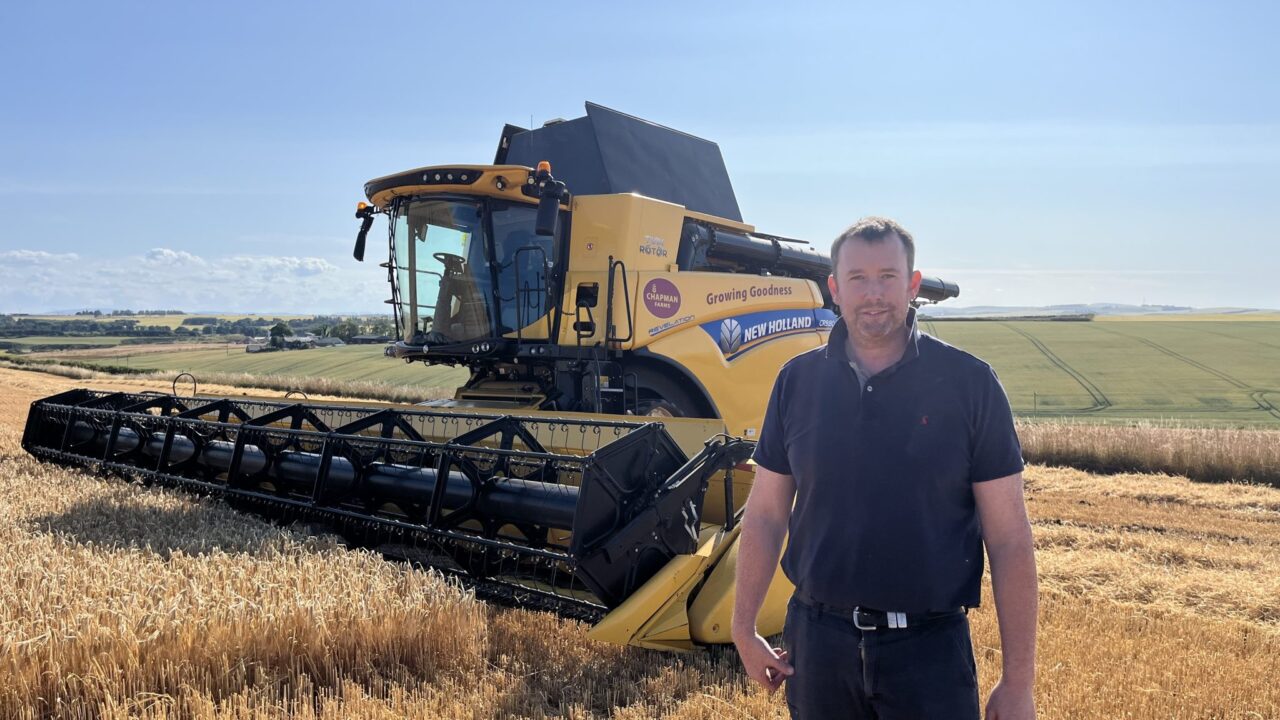While eggs are the primary focus of Aberdeenshire’s Farmlay Eggs, the head of one the UK’s best-known names in egg production always looks forward to the harvest.
“It’s my favourite time of year,” says Iain Chapman, managing director of his family’s £40 million turnover egg business Farmlay.
Father-of-three Iain is the first to admit the demands of running such a successful business make it a struggle to get out into the fields as much as he would like.
“I absolutely love getting my overalls on and going to see how our team’s getting on with the tractor work,” he said.
“Being up in the combine really is my happy place. I always like to do a wee bit. Anybody who has ever done a harvest season will understand that there is nothing to beat it, especially when you’re working with a great team like we have.”
Scottish farm
The Chapman family’s 2,500ac Cockmuir Farm, near Strichen in Aberdeenshire, grows 2,000ac of cereals made up of winter and spring barley, winter oilseed rape, and winter wheat.
The remaining acreage is down to grass for their herd of 230 commercial suckler cows and woodland for free-range hen habitats.

Farmlay own a total of 450,000 birds and there are a further 550,000 supplying eggs through contract producers, with both numbers expected to increase significantly over the next 12 months.
Keeping them fed is no small task. Farmlay’s feed requirement totals 450t of finished feed a week, made up of 300t of wheat and 100t barley with the remainder soya, limestone granules and rape meal.
The firm’s ration is mixed daily by Harbro using one of its mobile milling units. Any additional cereal needed on top of the Chapman’s acreage yields is bought in from farms within a 20-mile radius.
“We have several agreements with local farmers, be it buying in some grain or providing some hen muck in return for grain, thus helping other arable farmers to reduce use of artificial fertilisers and increase organic matter,” Iain continued.
“It’s important to us that we know where all the raw materials that are going into our feed come from.
“One other arrangement we have is selling our rape to a local contact who cold presses to extract the oil to sell to retail, and we receive the by-product rape meal back.
“It’s great stuff for replacing some of the soya. Of course, from a sustainability point of view, we try and reduce soya inclusion in our rations, but it’s easier said than done as it’s such a good protein source.”
Harvest 2025
Among this year’s grain carting crew will be 18-year-old Sophia Gibb, the daughter of the Chapman family’s farm manager John Gibb.
“Sophia is training to be a vet and has been coming and helping at harvest time for a couple of years now,” Iain explained.
“The harvest team is made up of the farm’s three full-time tractor men, plus one who looks after the cattle but crosses over at busy times, as do two of the poultry farm staff.

“We have a fantastic team here and I am extremely grateful for the extra effort everyone puts in at harvest.”
The farm runs two New Holland combines with 35ft headers, with a one-megawatt biomass boiler being put to good use when it comes to powering the grain dryer.
Iain says poultry muck has played more than its fair share in getting wheat yields up to a typical average of 4.5t/ac.
“We pretty much plough everything,” Iain said.
“We want a nice clean seed bed and don’t want to use too much herbicide for weed control. Apart from being stoney in places, the land is good and fertile.
“We were lucky enough to get some rain at the end of May and beginning of June, so our crops haven’t been as stressed as some.
“Germination was a bit patchy in places, but I think because of the good fertility of the soil – not only through hen muck but also the cattle manure – the crops are putting down good deep roots which help them survive droughty times.”
Outlook
Ideally, Iain would like to increase cattle numbers from 230 to 250 head. They are mostly made up of Simmental cows, crossed to a Charolais bull. It was his father, Robert, who founded the herd about 30 years ago.
“The cattle muck does a completely different job to hen’s, bringing depth to the soil rather than just nutrients,” Iain explained.
With the average laying hen only eating 125g of feed in a day, it is important that – with a 63g egg to lay – every grain is of the highest nutritional quality.
“My dad always says it has to be rocket fuel. I’ve always been brought up to believe that what you feed them – your cereal – is everything. That feed is just as vital as if we were feeding a racehorse or a high-yielding dairy cow,” he added.
“Growing our own corn and only buying in from trusted neighbouring farmers gives the hens the best possible diet; helping them to produce the best possible eggs.”
Iain’s father Robert left school at 15 with the ambition of owning 100,000 hens and 1,000ac of farmland.
When he passed over the reins as managing director to Iain in December 2023, the business owned 450,000 hens and 2,500ac of land – a nearly 20-fold increase from the 130ac he started out with.
These numbers will continue to grow as the business has significant growth in its sights.
“Although Farmlay has grown so much, both my dad and I would say we are still farmers at heart and that’s why harvest will always be such a special time for us as a family,” Iain said.

